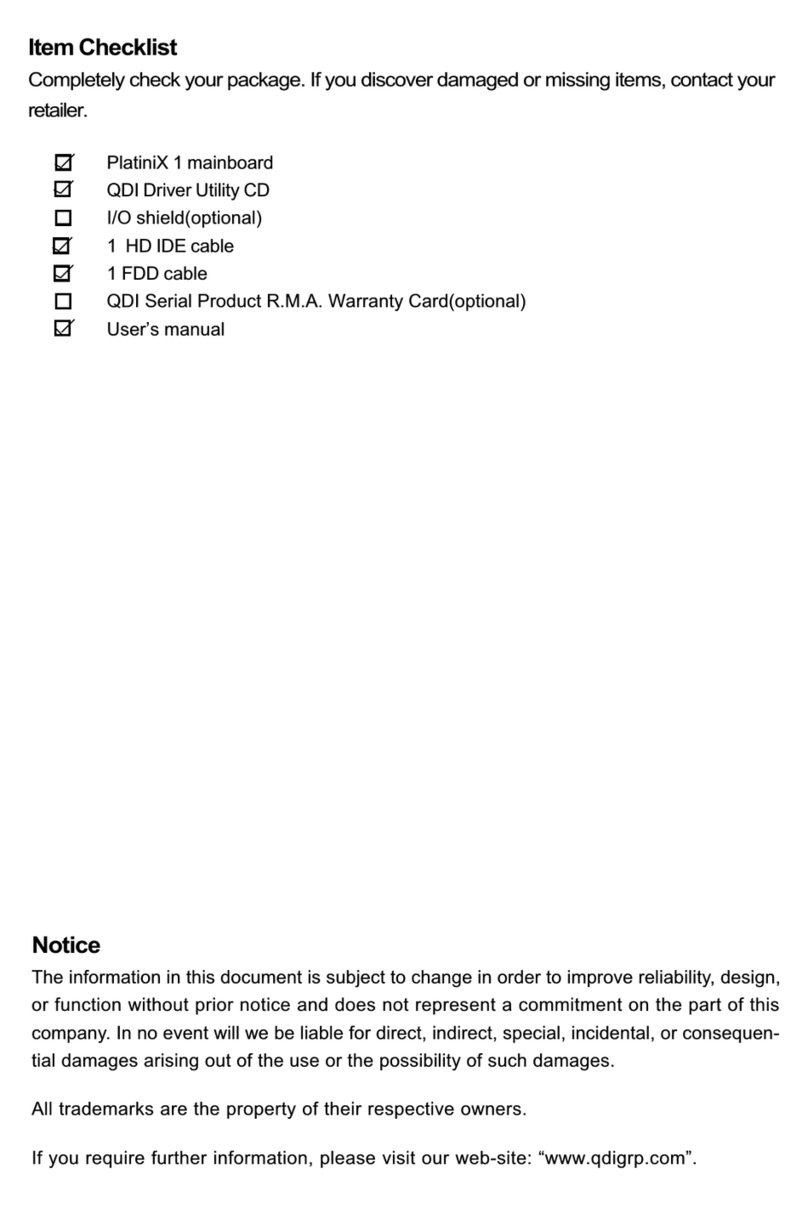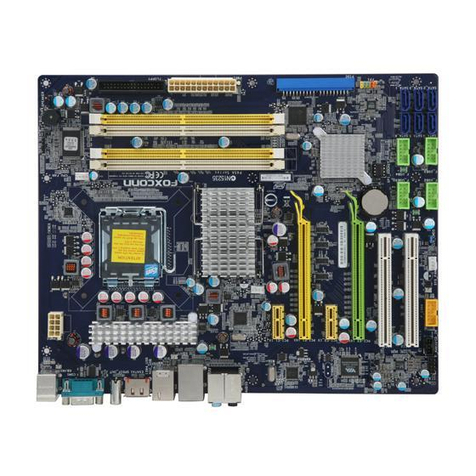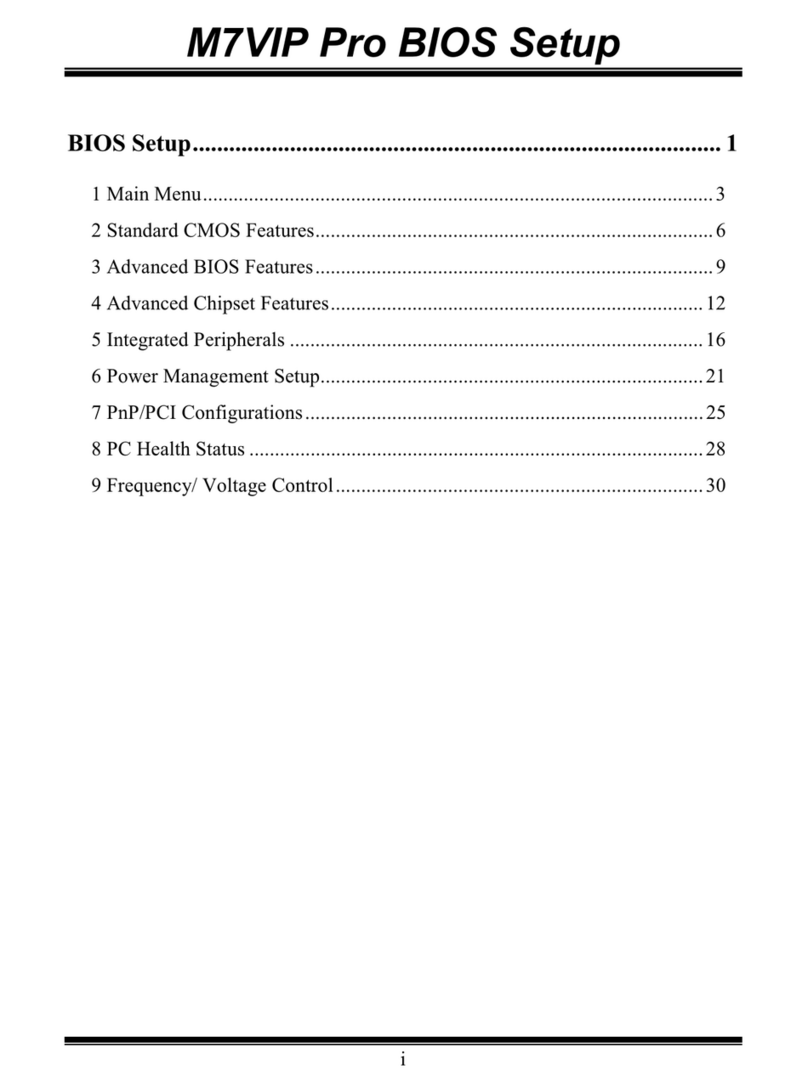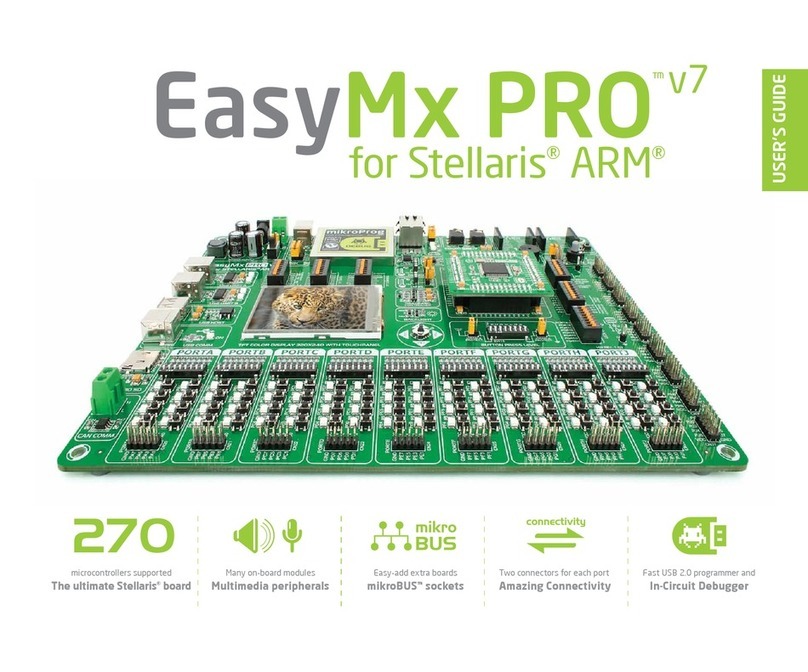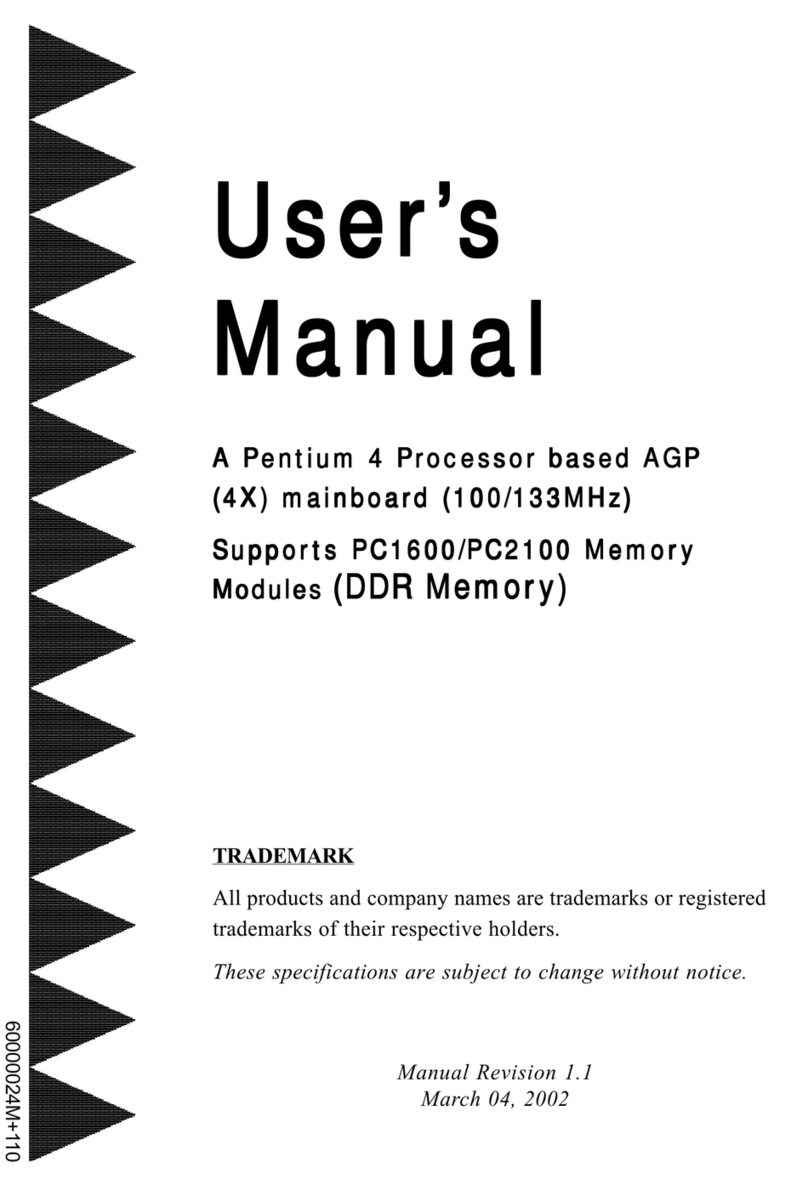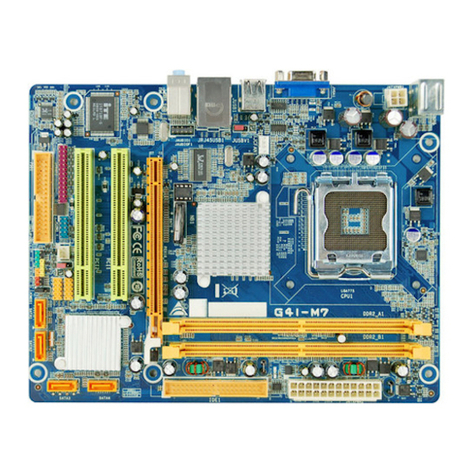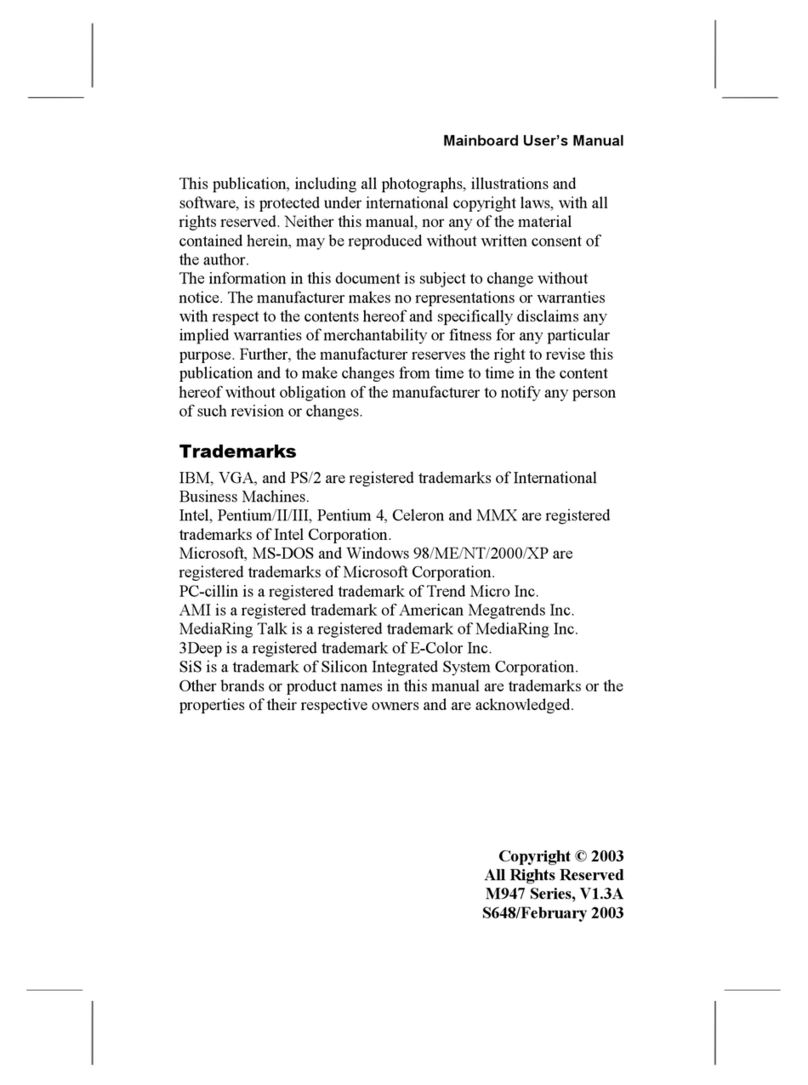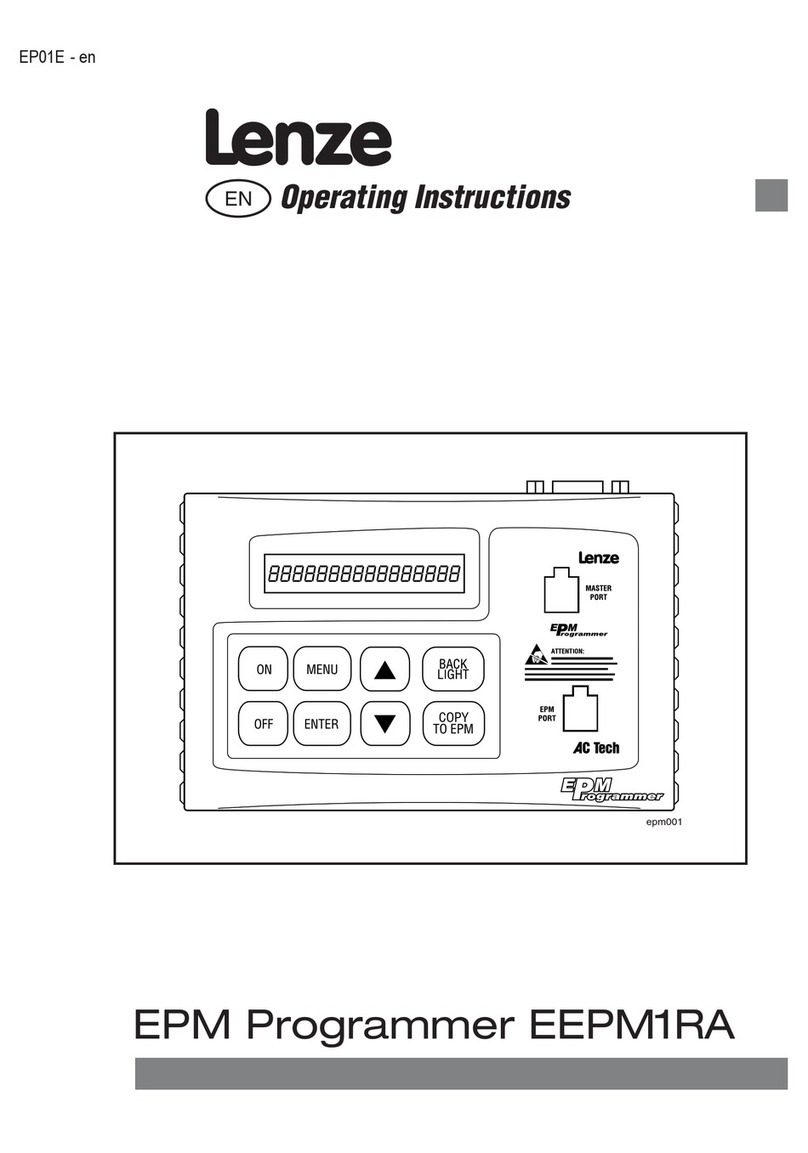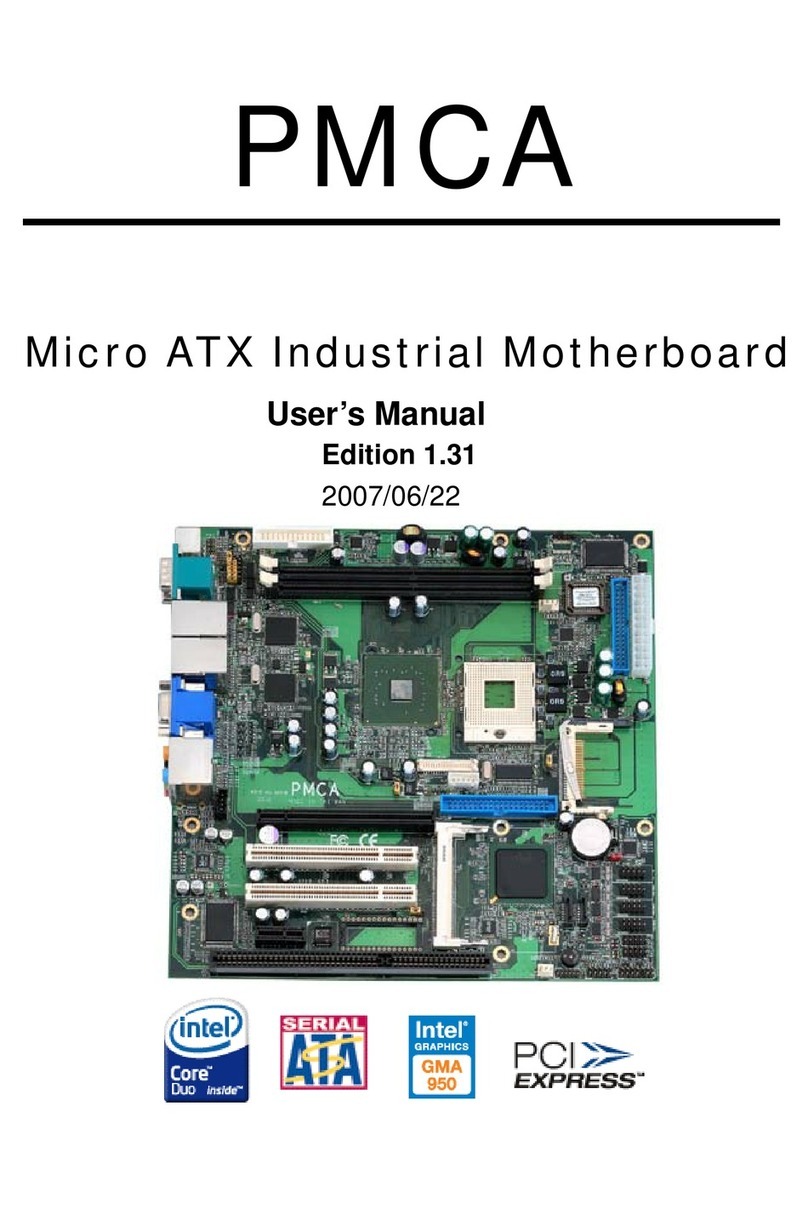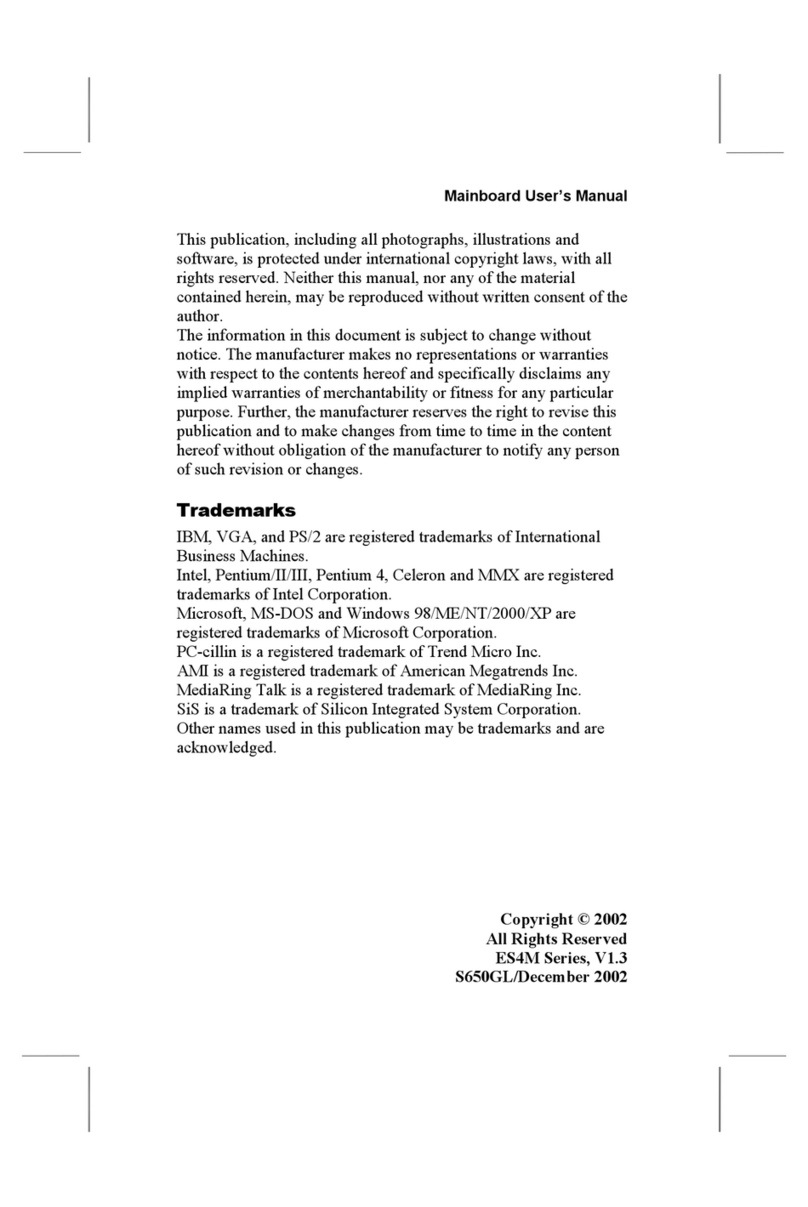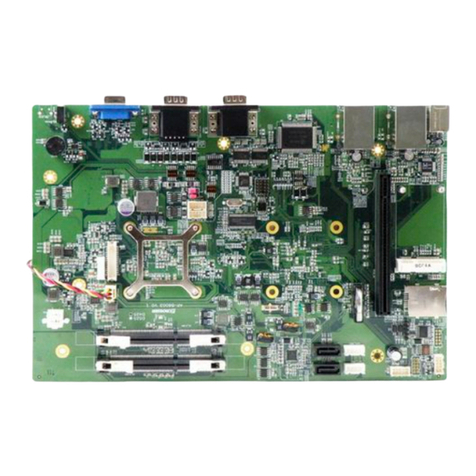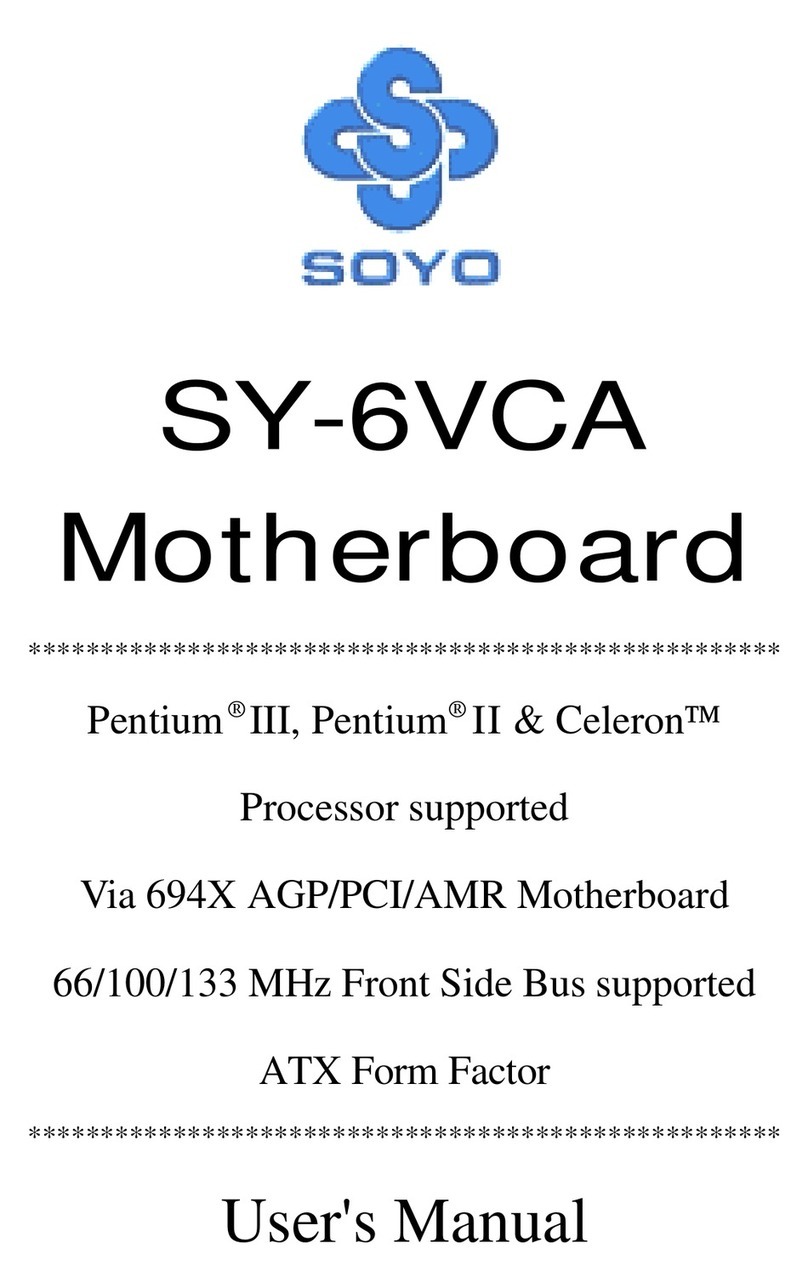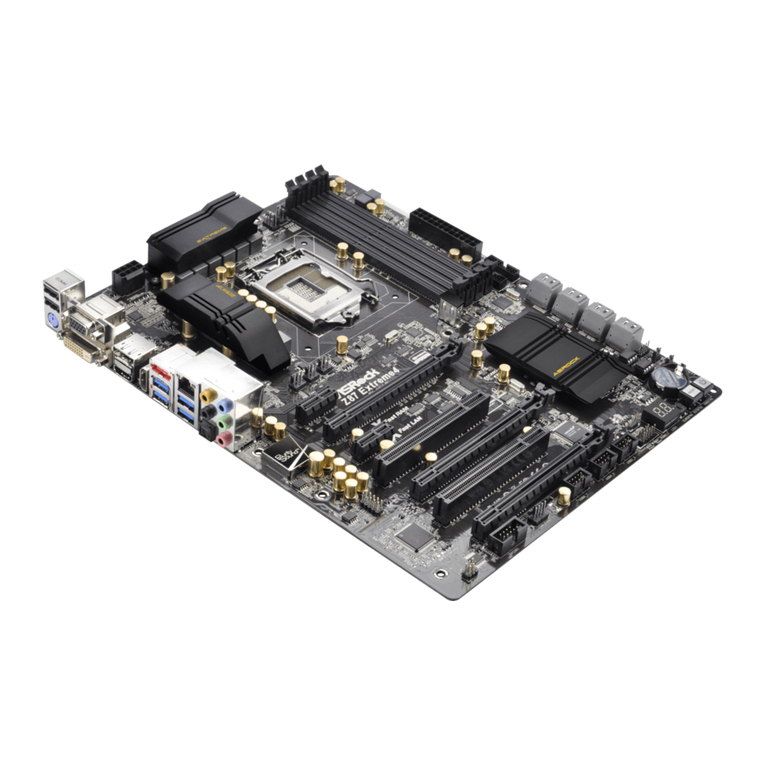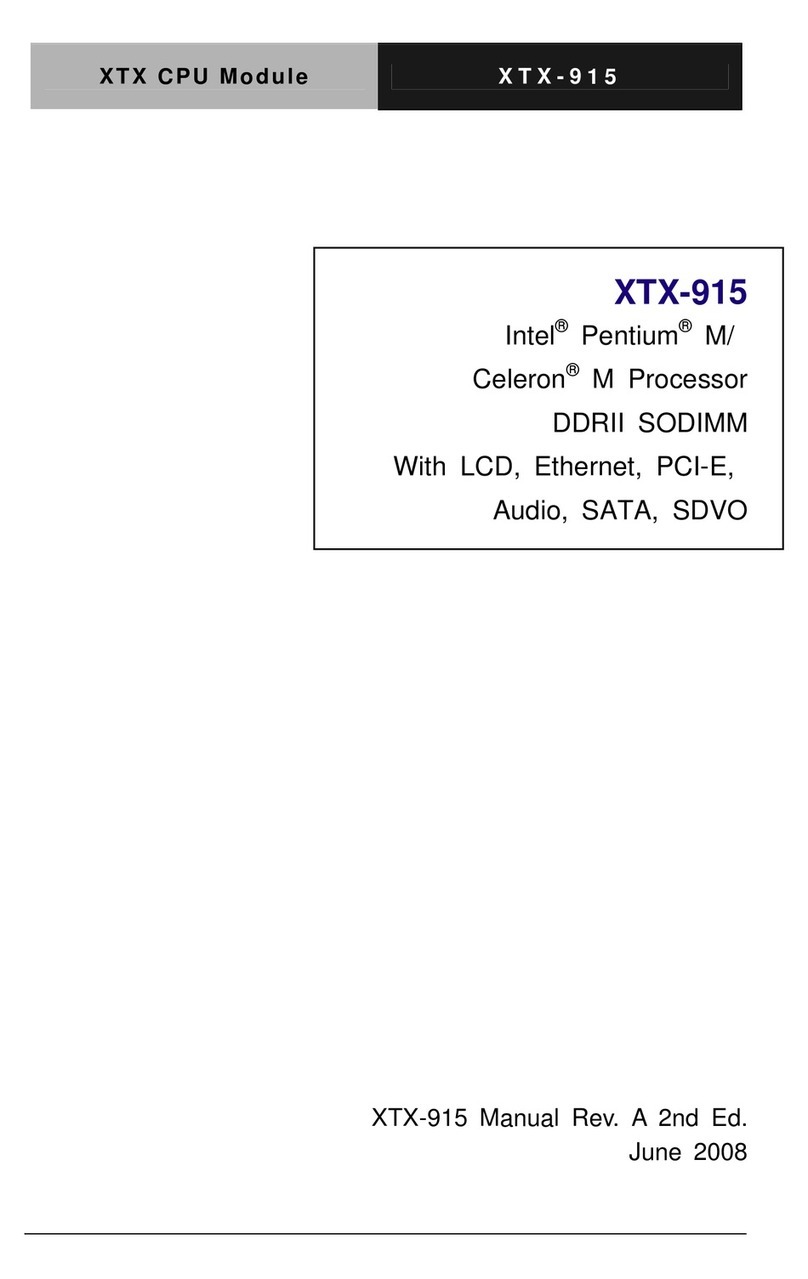Technologic Systems TS-7300 User manual

TS-7300 MANUAL
© Apr, 2010 www.embeddedARM.com 1
www.embeddedARM.com
Revision 1.7
© Apr, 2010
TS-7300 Manual
Hardware & Software

TS-7300 MANUAL
Feedback and Update to this Manual
To help our customers make the most of our products, we are continually making additional and
updated resources available on the Technolo ic Systems website (www.embeddedARM.com).
These include manuals, application notes, programming e amples, and updated software and
firmware. Check in periodically to see what's new!
When we are prioritizing work on these updated resources, feedback from customers (and prospective
customers) is the number one influence. If you have questions, comments, or concerns about your
Embedded Computer, please let us know at [email protected].
Limited Warranty
Technologic Systems warrants this product to be free of defects in material and workmanship for a
period of one year from date of purchase.
During this warranty period Technologic Systems will repair or replace the defective unit in accordance
with the following process:
A copy of the original invoice must be included when returning the defective unit to Technologic
Systems, Inc.
This limited warranty does not cover damages resulting from lightning or other power surges, misuse,
abuse, abnormal conditions of operation, or attempts to alter or modify the function of the product.
This warranty is limited to the repair or replacement of the defective unit. In no event shall Technologic
Systems be liable or responsible for any loss or damages, including but not limited to any lost profits,
incidental or consequential damages, loss of business, or anticipatory profits arising from the use or
inability to use this product.
Repairs made after the e piration of the warranty period are subject to a repair charge and the cost of
return shipping. Please, contact Technologic Systems to arrange for any repair service and to obtain
repair charge information.
FCC Advisory Statement
This equipment generates, uses, and can radiate radio frequency energy and if not installed and used
properly (that is, in strict accordance with the manufacturer’s instructions), may cause interference to
radio and television reception. It has been type tested and found to comply with the limits for a Class A
computing device in accordance with the specifications in Subpart J of Part 15 of FCC Rules, which
are designed to provide reasonable protection against such interference when operated in a
commercial environment. Operation of this equipment in a residential area is likely to cause
interference, in which case the owner will be required to correct the interference at his own e pense.
If this equipment does cause interference, which can be determined by turning the unit on and off, the
user is encouraged to try the following measures to correct the interference:
•Reorient the receiving antenna.
•Relocate the unit with respect to the receiver.
•Plug the unit into a different outlet so that the unit and receiver are on different branch circuits.
•Ensure that mounting screws and connector attachment screws are tightly secured.
•Ensure that good quality, shielded, and grounded cables are used for all data communications.
If necessary, the user should consult the dealer or an e perienced radio/television technician for
additional suggestions. The following booklets prepared by the Federal Communications Commission
(FCC) may also prove helpful:
•How to Identify and Resolve Radio-TV Interference Problems (Stock No. 004-000-000345-4)
•Interface Handbook (Stock No. 004-000-004505-7)
These booklets may be purchased from the Superintendent of Documents, U.S. Government Printing
Office, Washington, DC 20402.
© Apr, 2010 www.embeddedARM.com 2

TS-7300 MANUAL
TABLE OF CONTENTS
TABLE OF CONTENTS
1 INTRODUCTION................................................................................................................6
1.1 About this Manual...............................................................................................................6
1.2 Product Overview...............................................................................................................6
1.3 Benefits................................................................................................................................6
Out-of-the-Box Productivity.......................................................................................................6
Impressive Performance............................................................................................................7
Linux FPGA.................................................................................................................................7
SD Card Hi h-Security and Reliability......................................................................................7
1.4 Features...............................................................................................................................7
1.5 Confi urability....................................................................................................................8
On-board Options.......................................................................................................................8
External Accessories.................................................................................................................8
1.6 PC/104 Peripherals.............................................................................................................9
1.7 TS-ARM Development Kit.................................................................................................10
1.8 TS-ENC730 Enclosure......................................................................................................11
1.9 Software and Support.......................................................................................................12
Linux OS Support.....................................................................................................................12
Other OS Support ....................................................................................................................12
2 GETTING STARTED & SOFTWARE..............................................................................13
2.1 Installation Procedure......................................................................................................13
Handlin the Board Safely.......................................................................................................13
Setup and Installation Instructions ........................................................................................13
Setup Tools ..............................................................................................................................13
Setup Procedure ......................................................................................................................13
Disconnectin AC Power ........................................................................................................13
2.2 Console and Power Up.....................................................................................................13
2.3 General Boot Sequence....................................................................................................14
2.4 Fast Bootup Firmware......................................................................................................15
Installation.................................................................................................................................16
2.5 Loadin or Transferrin Files..........................................................................................17
Transferrin Files via the Ethernet Port.................................................................................17
Transferrin Files via Flash Memory Device..........................................................................17
Zmodem Downloads................................................................................................................17
2.6 SD Card Hi h-Security Features......................................................................................17
How to use it.............................................................................................................................18
2.7 Debian Linux OS...............................................................................................................18
apt- et.......................................................................................................................................19
Lo in In and Basic Commands...........................................................................................19
Shutdown..................................................................................................................................19
Initialization Scripts..................................................................................................................20
Network Setup..........................................................................................................................20
Settin Up the networkin with Debian..................................................................................20
3 HARDWARE COMPONENTS.........................................................................................21
3.1 Processor..........................................................................................................................21
Cirrus EP9302...........................................................................................................................21
MMU...........................................................................................................................................22
© Apr, 2010 www.embeddedARM.com 3

TS-7300 MANUAL
TABLE OF CONTENTS
Interrupts...................................................................................................................................22
3.2 Memory..............................................................................................................................23
On-Board SDRAM.....................................................................................................................23
Battery Backed SRAM..............................................................................................................24
On-Board NAND Flash.............................................................................................................24
USB Flash Drive or Compact Flash Card...............................................................................25
SD Memory Card.......................................................................................................................25
FPGA SDRAM...........................................................................................................................25
3.3 Glue Lo ic CPLD...............................................................................................................26
3.4 Cyclone II FPGA................................................................................................................26
3.5 Real-Time Clock................................................................................................................27
3.6 Watchdo Timer................................................................................................................27
4 COMMON INTERFACES GENERAL INFORMATION...................................................29
4.1 Serial Ports .......................................................................................................................29
4.2 Di ital I/O...........................................................................................................................29
4.3 A/D Converters..................................................................................................................30
5 CONNECTORS AND HEADERS....................................................................................31
5.1 10/100 Base-T Ethernet Connector..................................................................................31
5.2 Second 10/100 Base-T Ethernet Connector....................................................................31
5.3 Video Out Connector........................................................................................................32
5.4 USB Connector.................................................................................................................33
5.5 SD Card Connector – CPLD.............................................................................................33
5.6 SD Card Connector – FPGA.............................................................................................33
5.7 COM1 Connector...............................................................................................................34
5.8 COM2 Header....................................................................................................................34
Optional RS-485 Support.........................................................................................................35
RS-485 Quick-Start Procedure................................................................................................36
Automatic RS-485 TX Enable ..................................................................................................36
5.9 COM3-COM4-COM5-COM6 Headers................................................................................37
5.10 DIO1 Header....................................................................................................................37
SPI Interface..............................................................................................................................39
Matrix Keypad...........................................................................................................................39
A/D Converter - Cirrus EP9302................................................................................................39
Interpretin Cirrus A/D Converter...........................................................................................40
5.11 DIO2 Header....................................................................................................................40
TS-XDIO.....................................................................................................................................41
TS-XDIO Pro rammin Considerations .................................................................................43
5.12 LCD Header.....................................................................................................................43
LCD Interface............................................................................................................................44
5.13 JTAG Header...................................................................................................................45
5.14 Power Supply Header.....................................................................................................46
6 PC/104 BUS EXPANSION..............................................................................................47
6.1 Addin Serial Ports ..........................................................................................................48
6.2 Addin Ethernet Ports .....................................................................................................49
6.3 Addin CAN Bus ..............................................................................................................49
6.4 Addin Video Support .....................................................................................................49
7 LEDS, JUMPERS AND BUTTONS.................................................................................50
© Apr, 2010 www.embeddedARM.com 4

TS-7300 MANUAL
TABLE OF CONTENTS
7.1 Status LEDs.......................................................................................................................50
7.2 Jumpers.............................................................................................................................50
7.3 Buttons..............................................................................................................................50
8 SPECIFICATIONS...........................................................................................................51
9 FURTHER REFERENCES..............................................................................................52
APPENDIX A: DOCUMENT HISTORY...............................................................................53
APPENDIX B: MEMORY AND REGISTER MAP...............................................................54
APPENDIX C: DOWNLOADS - SCHEMATICS AND MECHANICAL DRAWING............56
APPENDIX D: TS-ARM SBC FEATURE MATRIX.............................................................57
APPENDIX E: CONTACT TECHNOLOGIC SYSTEMS.....................................................58
© Apr, 2010 www.embeddedARM.com 5

TS-7300 MANUAL
INT ODUCTION
1 INTRODUCTION
1.1 About this Manual
This manual is intended to provide the user with an overview of the board and benefits,
complete features specifications, and set up procedures. It contains important safety
information as well.
1.2 Product Overview
The TS-7300 Single Board Computer runs on a 200 MHz ARM9 processor with power
under 2 Watt. Low board comple ity, low component count, and low power/heat makes for
an e tremely reliable embedded engine. The TS-7300 SBC's are available in thousands of
configurations, many of which are Commercial off the Shelf (COTS) and available to ship
today.
The EP9302 processor from Cirrus is the highly integrated 200Mhz ARM9 processor that
the TS-7300 SBC's are built around and includes an on-chip 10/100 ethernet, USB, serial,
and Flash/SDRAM controller. A supplemental PLD provides glue logic, watchdog timer,
Compact Flash IDE, and 8 bit PC/104 support. Integer CPU performance is about 20%
faster than our 133 Mhz 86 offerings.
Even with the standard power consumption of 2 Watts, the TS-7300 SBC’s run without
fans or heat sinks in the temperature range of -20° to +70°C. E tended Temperature -40°
to +85°C is also standard, but CPU clock must be decreased to about 166MHz for higher
temperatures. Digital Signal Processing (DSP) is enabled through a standard 5 channel,
12bit A/D converter (Optional 8 channel, 12 bit A/D converter), 20 DIO lines and 2
standard serial ports.
The 8/16 bit PC/104 interface enables additional functionality through Technologic
Systems’ broad product line of PC/104 peripheral daughter boards. The TS-7KV adds
video, CAN, Com Ports, and A/D conversion. The TS-ETH10 allows the addition of
Ethernet ports. The TS-CAN adds CAN connectivity. The TS-Modem boards add both
wired and cell phone capabilities.
The TS-7300 is a compact, full-featured Single Board Computer (SBC) based upon the
Cirrus EP9302 ARM9 CPU. The EP9302 features an advanced 200 MHz ARM920T
processor design with a memory management unit (MMU) that allows support for high
level operating systems such as Linu , Windows CE, and other. As a general-purpose
processor, it provides a standard set of peripherals on board and a full set of Technologic
Systems featured peripherals via the standard PC/104 Bus.
The TS-7300 is a multipurpose board designed specifically for customers needing
e treme design security, fle ibility and reliability in applications such as gaming machines,
building security equipment, or critical network infrastructure services such as network
gateways or firewalls. Included on the board is a 8256 LUT Cyclone II FPGA that is
reprogrammable on-the-fly by the 200Mhz ARM9 CPU running Debian Linu when an
additional real-time soft-coprocessor(s), DSP, or specific additional peripheral logic is
needed.
1.3 Benefits
Out-of-the-Box Productivity
Technologic Systems Linu products get you to your application quickly. Our Single Board
Computers boot directly to Linu as shipped. There is no complicated CMOS setup or
configuring of a Linu derivative Operating System to source, define, and load.
Technologic Systems has pre-configured each SBC in flash memory.
© Apr, 2010 www.embeddedARM.com 6

TS-7300 MANUAL
INT ODUCTION
The TS-7300's user can power up the board and immediately begin application
development. Of course, should you wish to configure your own version of Linu or use a
different operating system, this is easy too. Technologic Systems provides the solution to
fast application development without tedious OS configuration.
Impressive Performance
The ARM920T's 32-bit architecture, with a five-stage pipeline, delivers very impressive
performance at very low power. The EP9302 CPU has a 16 KB instruction cache and a 16
KB data cache to provide zero-cycle latency to the current program and data, or they can
be locked to guarantee no-latency access to critical sections of instructions and data. For
applications with instruction-memory size restrictions, the ARM920T’s compressed Thumb
instruction set can be used to provide higher code density and lower Flash storage
requirements.
As a benchmark, the TS-7300's CPU integer performance, at a supplied 200 MHz, is
about twice as fast as the Technologic Systems 133MHz 586-based products.
Linux FPGA
The inclusion of an Altera FPGA and a dedicated high-speed bus between the CPU and
FPGA provides unique design possibilities in the hands of creative embedded designers.
The FPGA has its own dedicated 8MB SDRAM and customers can load their own
bitstream or use the default TS built bitstream that provides the hardware logic for the 8
serial ports, second 10/100 ethernet port, second SD card slot, VGA video and up to 35
DIO lines connected straight to the FPGA. These DIO lines can also be used as a FPGA
connected e pansion bus instead of the CPU connected regular PC104 e pansion bus.
SD Card igh-Security and Reliability
Unique security features on the TS-7300 include the ability for the board hardware to first
checksum the boot SD flash card in its entirety before e ecuting a single instruction of
code from it. One may also use the security features of a SD card to hardware lock and
password protect the boot flash card so that the card is only bootable and readable on a
specific TS-7300 device. Any SD flash card can also be made read-only permanently and
irreversibly once your product is finalized for additional design security.
The board also includes many features for high reliability computing and control. SD flash
technology is already e tremely reliable compared to hard drives, but with 2 hot-
swappable flash card sockets running full-blown operating systems such as Linu , you
have the option to use RAID on your flash devices to protect against potential individual
flash write wearout failures. Also, every component on the board is rated for 70 or 80
degrees Celsius ambient temperatures without heat sinks or fans. Unlike typical
"embedded" PC or laptop motherboards which can barely sustain thermal balance at
room temperature with large heatsinks, the TS-7300 operates with relatively huge margins
in similar conditions which increases hardware lifetime and reliability.
1.4 Features
The TS-7300 comes standard with these features:
✔200Mhz ARM9 with MMU and 32 MB SDRAM
✔User-programmable Altera 2C8 Cyclone II FPGA
✔2 SD Card flash sockets
✔TS-VIDCORE VGA video-out w/8MB dedicated video RAM
✔2 USB 2.0 Compatible OHCI ports (12 Mbit/s Ma )
✔2 10/100 ethernet ports
✔10 RS232 serial ports
© Apr, 2010 www.embeddedARM.com 7

TS-7300 MANUAL
INT ODUCTION
✔55 DIO ports (up to 35 TS-XDIO capable on FPGA)
✔1.8 watts power (CPU/SDRAM full speed, ethernets on but unplugged, all serial ports
on, and with default FPGA bitstream)
✔Fast boot to Linu prompt-shell in 1.69 seconds, Linu -based bootloader
✔Watchdog timer
✔PC/104 e pansion bus
✔SPI bus interface
✔Matri keypad and te t mode LCD support
✔Operating Temperature Range: Fanless from -20° to +70°C
✔E tended Temperature -40° to +85°C standard at lower CPU clock speeds
1.5 Confi urability
The TS-7300 can be configured for your application using the following available on-board
options and e ternal accessories:
On-board Options
✔TS-7300-yyy: TS-7300 with up to 128 MB of on-board SDRAM. For e ample, TS-7300-
64 selects model TS-7300 with 64 MB of SDRAM.
✔OP-BBRTC: on-board sealed-battery backed RTC
✔OP-TMPSENSE: High-precision temperature sensor
✔OP-485-FD: RS-485 full duple interface on COM2
✔OP-485-HD: RS-485 half duple interface on COM2
✔OP-ROHS: RoHS directive compliant built board
Note
The TS-7300 SBC can be built compliant with the RoHS (Restriction of Hazardous
Substances ) Directive. Contact Technologic Systems for RoHS support.
External Accessories
✔SD-512: 512 MB SD Flash Card with full ARM tool chain installed and Debian
✔USB Flash Drive: 256 MB with full ARM tool chain installed and Debian
✔WIFI-G-USB: Linu -supported USB 802.11g WiFi transceiver for wireless networking
✔OP-LCD-LED: Alphanumeric 2 24 LCD with back light and cable
✔OP-KPAD: Matri keypad with cable
✔PS-5VDC-REG: Regulated 5VDC Power Supply, 110 VAC Input
✔TS-ENC730: Metal Enclosure with Power Converter and additional features
✔RC-DB9: COM2 adapter cable to DB-9
In addition, a complete set of interfacing cables, connectors, and enclosures is available.
Note
Check our website at www.embeddedARM.com for an updated list of options
and e ternal accessories
© Apr, 2010 www.embeddedARM.com 8

TS-7300 MANUAL
INT ODUCTION
1.6 PC/104 Peripherals
Technologic Systems offers many add-on peripherals to complete the requirements of
your application. These products directly interface with the TS-7300 using the PC/104
bus, adding a wide variety of functionalities at very reasonable prices. Some of these
functionalities includes:
✔NVRAM - adds 32K, 128K, 1MB or 2MB bytes of battery-backed SRAM. Battery
backed SRAM provides non-volatile memory with very fast write times and unlimited
write cycles, unlike Flash memory. This can be very important if the data is constantly
being updated several times per minute, since Flash devices can wear-out after a few
million write cycles. It also eliminates the latency that Flash memory has during write
cycles. This resource is a byte-wide memory device using a lithium battery that will last
a minimum of 10 years with or without power applied.
✔Analog VIDEO interface – When a video monitor is needed.
✔CAN Bus – Useful for automotive applications.
✔Modems – Phone Line or GSM Cellular modems.
✔Additional Ethernet ports.
✔Additional DIO interface with either 24 or 64 new lines..
✔Additional 12 bit ADC and DAC: useful for industrial automation applications.
✔Additional COM and Parallel ports – Make more communication channels available.
✔Power-over-Ethernet
✔Radios – Long-range wireless radios, Xbee modules
Note
New PC/104 boards are always in development. Contact Technologic Systems or
visit the PC/104 peripherals pa e at our website for a complete and updated list
of additional functionalities that can be added to the TS-7300 using the PC/104
bus. You can also contact Technologic Systems about your custom project
desi n.
© Apr, 2010 www.embeddedARM.com 9

TS-7300 MANUAL
INT ODUCTION
1.7 TS-ARM Development Kit
The TS-ARM Development Kit for the TS-7300 Single Board Computer includes all
equipment necessary to boot into the operating system of choice and start working. The
development kit is highly recommended for a quick start on application development.
The TS-ARM Development Kit contains a 256 or 512 MB Flash drive (SD Card) which
includes:
✔a self-hosting ARM installation of the Debian Linux 3.0 distribution compiled for ARM
✔gcc 2.95.4 and gcc 3.0 compiler with full tool-chain
✔Hardware test routines source code and other e ample source code
✔Debian package system: apt-get, tasksel, dselect
The development kit additionally includes:
✔SD Card reader
✔5 VDC regulated power supply (international versions available)
✔NULL modem cable
✔Adapter cable from 10-pin header to DB9
✔Various cables for connection DIO, LCD, Keypad, etc.
✔Development CD with complete TS-Kernel source, manuals, e ample code, etc.
✔Printed supporting documentation for TS-7300 Hardware, Linu for ARM and
Development Kit.
Note
Single Board Computer is not included on the Development Kit (sold separately).
© Apr, 2010 www.embeddedARM.com 10

TS-7300 MANUAL
INT ODUCTION
1.8 TS-ENC730 Enclosure
The TS-ENC730 metal enclosure is made to house the TS-7300 Single Board Computer
and up to two PC/104 peripheral boards. The internal power regulator efficiently converts
unregulated 7-28 VDC input into regulated +5 VDC required by the SBC. Sleep mode
allows current drain of 200 microAmps with programmable sleep period.
The TS-ENC730 brings out some features implemented on the TS-7300 FPGA, such as
the SJA1000 CAN core, PWM for the DAC lines, 800 600 VGA Video, second ethernet
port, additional serial ports, etc.
Furthermore, the TS-ENC730 includes the TS-732 daughter board for the TS-7300
onboard FPGA. The AVR microcontroller on the TS-732 implements ADC/GPIO/LEDs
e tra functionalities. Also, the physical layer for the CAN bus is provided by the TS-732.
Additional features include:
✔8-28 VDC power input
✔User programmable low power sleep mode (300 uA)
✔Surge suppression on power input
✔Terminal strip with 8 I/O
✔4 channel 10 bit ADC 0V - 5V (12-16 bits effective*)
✔2 channel 12 bit high power DAC 0V - 10V (sync/source 300mA)
✔4 high current GPIO pins (sync/source 400 mA)
✔5-8 COM ports
✔Two software controlled LEDs
✔Status LEDs for both Ethernet ports
✔Optional CAN bus port with Linu driver available
✔Linu Application available for ADC/DAC/GPIO/LEDs control
✔Sturdy metal design reduces noise
© Apr, 2010 www.embeddedARM.com 11

TS-7300 MANUAL
INT ODUCTION
1.9 Software and Support
Technologic Systems provides:
✔Free system software and documentation updates available on our web site
✔Free technical support by phone, fa , or email
✔30-day, money back guarantee on evaluation units
✔One-year, full warranty
Linux OS Support
The ARM processor (the EP9302) comes from Cirrus and the platform is very similar to
the Cirrus EDB9302 evaluation board. Cirrus has strongly promoted running Linu on this
chip and has done most of the legwork in creating a patch set to the Linu 2.4 kernels, but
we have also had to modify the Linu Kernel (TS-Kernel) so it can support NAND nad
NOR Flash chips (via mtd drivers), a compact flash IDE driver, A/D converters, SD Card
through the TS-SDCORE, video, additional ethernet ports and more. If you want to use
Linu and aren't tied to the 86 architecture, the TS-7300 can be very cost-effective.
The TS-7300 SBC's proprietary boot firmware makes
it possible for the board to boot directly from the SD
Card on the first socket, therefore the TS-7300's are
shipped standard with the full-featured Debian Linu
installed on the first SD Card. Debian can also be
used with an NFS root file system or USB flash
drives. The TS-Kernel used is based upon the version
2.4.26, patched and compiled for the Cirrus EP9302
ARM920T processor, and is real-time capable
through RTAI.
The root file system used by the Linu OS can be any of the following:
✔EXT2 file system image in the SD card
✔JFFS/YAFFS file system image in the on-board Flash (on-board flash is a non-
standard option on the TS-7300, please contact Technologic Systems)
✔NFS root, via Ethernet port (after fast bootup, one need to mount a NFS root and
chroot to it)
Note
The TS-Kernel supports the Real-Time Application Interface (RTAI project),
making the embedded operating system capable of handling applications with
hard real-time restrictions.
Other OS Support
The TS-7300 can be loaded with other operating systems such as Windows CE, NetBSD,
etc. Technologic Systems will provide support for these, and possibly other operating
systems, in the future. Currently, only Linux and NetBSD are supported on the TS-7300.
© Apr, 2010 www.embeddedARM.com 12

TS-7300 MANUAL
GETTING STA TED & SOFTWA E
2 GETTING STARTED & SOFTWARE
2.1 Installation Procedure
Before performing any set up or placement procedures, take the precautions outlined in
this section.
andling the Board Safely
Be sure to take appropriate Electrostatic Discharge (ESD) precautions. Disconnect the
power source before moving, cabling, or performing any set up procedures.
!Warnin
Inappropriate handling may cause damage to the board.
Setup and Installation Instructions
Follow these guidelines for safety and ma imum product performance:
✔Observe local health and safety requirements and guidelines for manual material
handling
Setup Tools
Depending on placement and cabling, you may need the following tools:
✔Small flat-blade screwdriver
✔Small Phillips screwdriver
Setup Procedure
After locating, setting up, grounding, and cabling the TS-7300:
✔Apply power
✔Monitor the TS-7300 using a terminal emulator to verify that the board is operating
properly
Note
Your board might include a screw power connector on the power input. Notice this
connector is removible. Please pull this connectior off before applying power.
Disconnecting AC Power
✔Unplug from the power source.
✔Disconnect other cables as required.
2.2 Console and Power Up
Although the TS-7300 presents a VGA video output, the COM1 port is typically used as a
console port to interface the TS-7300 to a standard terminal emulation program on a Host
PC via a serial cable.
An ANSI terminal or a PC running a terminal emulator is required to communicate with
your Embedded PC. Simply connect an ANSI terminal (or emulator) to COM1 (DB9
female connector) using a null modem cable (this is included in the TS-ARM Development
Kit), using serial parameters of 115,200 baud, 8 data bits, no parity, no flow control, 1 stop
bit, and make sure jumper JP2 is installed. If you are running Linu , the minicom program
works well, Windows users can run the Hyperterm application. Technologic Systems
offers a null modem cable with both 25 pin and 9 pin connectors at each end as part
number CB7-05. Some systems also require the 10-pin header to 9-pin Sub-D adapter
© Apr, 2010 www.embeddedARM.com 13

TS-7300 MANUAL
GETTING STA TED & SOFTWA E
which is P/N: RC-DB9.
The console can be changed to COM2 by installing JP4 (with JP2 also installed). If your
application does not require a console or both COM ports are required, then removing the
jumper JP2 easily disables all console output and redirects it to VGA output.
Connect a regulated 5VDC, (1A minimum) power source using the included 2 screw
terminal strip/connector. Please note the polarity printed on the board. The boot
messages, by default, are all displayed on COM1 at 115200 baud.
Alternatively, one can also use a USB keyboard attached to the USB host port on the TS-
7300 and a VGA monitor attached to the VGA video out on the TS-7300 in order to
interface with the SBC. A Technologic Systems logo splash and a shell prompt to the root
file system will be shown on the VGA display a few seconds after Ts-7300's power cycle.
The console on COM1 will still be active though.
2.3 General Boot Sequence
The TS-7300 differs from the previous TS-72XX boards in the way it implements its
bootloader. The TS-7300 does not make use of Redboot or any other traditional
bootloader. Instead, the TS-7300 uses a proprietary firmware that enables fast boot to
Liniu from the SD Card on the first socket.
Technologic Systems has written a binary Linu driver module and a set of generic, OS-
independent read/write routines for accessing the SD flash inside of an ARM object (.o)
file. The system boots to an initrd to load the SD driver as a module, since a pre-compiled
kernel with the driver built-in could not be provided.
The on-board EEPROM contains code to talk to SD and the board actually boots directly
to SD. The hand off from the bootrom to the SD card is very similar to 86 bootup. The
first 512 bytes of the SD card (the MBR) is loaded into ram and jumped into. The code
inside the MBR calls the BOOTROM routines to read more blocks from the SD card
(similar to 86 DOS int 13h) and bootstrap itself.
Currently, our MBR code (Only 446 bytes available after partition table) loads in a kernel
and an initrd from dedicated partitions on the SD card and starts Linu . The initrd
contains the FPGA bitstream and the Linu driver modules for SD. These are loaded
(along with modules for the ethernet and serial ports) and then the initrd does a pivot_root
to the SD EXT2 file system and then frees the initrd. There is no on-board flash on the
TS-7300, only SD.
The following is a complete description of the TS-7300 bootup process:
1) Power-on. For appro . 200ms, both LEDs will be illuminated indicating the processor is
receiving voltage but is being kept in reset waiting for power to stabilize. On-board MAX2
CPLD arms watchdog for 8 second e piry.
2) CPU begins e ecuting mask-ROM bootup code. This code looks for the magic string
"CRUS" in the SPI EEPROM chip. Red LED is now turned off.
3) CPU mask-ROM finds CRUS in SPI EEPROM and loads 2 kilobytes of EEPROM into
on-chip SRAM. Processor then jumps into on-chip SRAM which now contains the TS-
SDBOOT mini-loader. If the magic string "CRUS" is not found in the EEPROM (due to
missing or malfunctioning SPI EEPROM chip) the processor locks up while fast blinking
the green LED. 8 seconds later the CPLD watchdog will reset the board and try the whole
process again.
4) TS-SDBOOT initializes SDRAM, bus timing, MAC addresses and performs self tests. If
a major failure is detected, board disarms watchdog and turns off the green LED, turns on
the red LED, and blinks off 3 times every 2 seconds.
5) TS-SDBOOT e amines the 36 byte security block at the last 36 bytes of the EEPROM.
Based on its contents, the board may:
© Apr, 2010 www.embeddedARM.com 14

TS-7300 MANUAL
GETTING STA TED & SOFTWA E
✔checksum and verify a predetermined number of sectors of SD flash
✔verify a password typed to the console within 8 seconds of bootup
✔verify a specific SD card serial number
✔force booting only to a locked SD card
✔unlock a locked SD card
✔verify the CPU unique ID
✔use the CPU unique ID to decrypt the SD unlock key
✔use the typed password to decrypt the SD unlock key
6) After security processing, TS-SDBOOT loads the first 512 bytes of the SD card to
physical SDRAM at address 0 1000. Control is transferred in ARM Thumb mode and two
parameters are passed. In register r0 is the address to the TS-SDBOOT routine for
reading blocks from the SD card and in register r1 a routine to print messages to the serial
port is passed. The C stack pointer still is in on-chip SRAM. The C prototypes of these
functions are as follows:
✔void sdread(unsigned int start_sector, char *buffer, int num_sectors)
✔void ser_puts(char *buffer)
If the SD boot sector contains bad code, the SD card is not present, or in the case of
another unforseen problem with either the system, SD card, or the boot program that
keeps the board from booting Linu , the watchdog will e pire and reset the board in
appro . 7.5 seconds.
7) The first 446 bytes of sector 0 contain Thumb program code that loads the first partition
with id 0 da as a kernel image at RAM location 0 218000 and the ne t with id 0 da as a
Linu initrd at 0 1000000. Linu ATAGs are composed and the kernel image is jumped
into.
8) The kernel decompresses itself and initializes. The 8 second watchdog is now
disabled. The compressed initrd is found, decompressed, and mounted as the root
filesystem.
9) The kernel invokes the program /linu rc on the initrd, which loads the TS-7300 FPGA
and kernel modules for FPGA components. (serial driver, ethernet driver, SD card driver,
and video driver) A splash screen is displayed on the VGA out.
10) As a last step, the /linu rc code mounts /dev/sdcard0/disc0/part3 and pivots to this as
the root filesystem and calls /sbin/init on the SD card filesystem. This starts either the
Debian or the TS-Linu initialization sequence.
Technologic Systems provides binary dd images of a bootable SD card for download and
also provide a utility to install just the MBR code on an arbitrary (pre-partitioned) SD card.
2.4 Fast Bootup Firmware
Through software optimizations, the TS-7300 ARM SBC is able to bootup to a Linu
prompt just 1.69 seconds after power-up. Technologic Systems provides a SD Card
image that includes kernel tweaks, initrd tweaks and a few tweaks inside the Debian
filesystem itself on partition 3. In addition, fast boot optimizations have also been applied
to the TS-SDBOOT bootup firmware that resides in ROM memory.
© Apr, 2010 www.embeddedARM.com 15

TS-7300 MANUAL
GETTING STA TED & SOFTWA E
The new SD image will look at the state of jumper 6. If jumper 6 is on, the full Debian
bootup will be bypassed and the system will instead drop straight to a shell prompt. 1.69
seconds after power-on the serial console prompt is active and 2.41 seconds after power-
on the video console is displayed. Video takes a bit longer to start up due to the fact that
the FPGA must be initialized, a splash screen is displayed, and USB keyboard kernel
modules must be loaded. To initiate a full Debian startup, simply type "e it" at either the
shell prompt on the serial port or the shell prompt on the VGA monitor (using keyboard).
The time it takes for bootup is also displayed right before the SH prompt is printed. On
new Rev C CPLD TS-7300's, the CPLD has a 32-bit counter that starts at 0 at poweron
and is used to measure the bootup time e tremely accurately. On other boards, the
EP9302 983Khz debug4 timer is used since it starts out as 0 also, but is slightly less
accurate than the 32-bit 14.7Mhz counter implemented in the new CPLD rev.
If you want something other than a shell prompt running as soon as possible on bootup, it
is possible by editing the /linu rc2 shell script on the initrd. When you do the fast boot, you
are actually booting to an initrd with the Debian parts of filesystem mounted read-only.
After modifying the /linu rc2 shell script on the initrd, run the "save" command to save the
initrd back to the SD card, otherwise your changes won't "stick".
The TS-7300 bootup firmware was designed to be much faster than a 86 PC/SBC BIOS.
So even better bootup times can be achieved with an RTOS, such as eCos, instead of
Linu . Of that 1.69s bootup time, about 1.4 represents Linu bootstrap, while about 0.3 of
it is the hardware initialization.
Installation
If you board doesn't have the Fast Bootup firmware installed from factory, proceed as
follow in order to have your TS-7300 upgraded.
The new SD Card image that enables the fast bootup option is available on our FTP site.
Visit our website, TS-7300 page, for further information.
It requires at least a 256MB SD Card. To install it, follow the instructions below:
1. E tract the new SD Card image file, for e ample:
$ bunzip2 fastboot 7300 sdcard 7 6 2006.dd.bz2
2. Using an SD Card reader and the "dd" utility, copy the image to the disc device
of the 256MB SD Card:
$ dd if=fastboot 7300 sdcard 7 6 2006.dd of=/dev/sda
Or, using the second SD Card slot of your TS-7300:
$ dd if=fastboot 7300 sdcard 7 6 2006.dd of=/dev/sdcard1/disc0/disc
!Warnin
This will completely overwrite the contents of your SD Card, so make
sure you do the appropriate backups before updating.
3. To use the image on a larger card (512MB, for e ample), just "dd" to the larger
card, use fdisk to increase the size of part3 to the remaining space (taking care
to keep the same start sector), and then use the "e t2resize" command on that
partition:
$ fdisk /dev/sdcard1/disc0/disc
$ ext2resize /dev/sdcard1/disc0/part3
4. To update to the new TS-SDBOOT, download and run (as root) the
TS-SDBOOT update utility binary e ecutable on your TS-7300 board. This utility is
found at our webiste.
© Apr, 2010 www.embeddedARM.com 16

TS-7300 MANUAL
GETTING STA TED & SOFTWA E
2.5 Loadin or Transferrin Files
Three methods are available for transferring files between a desktop PC and your TS-
7300: Ethernet downloads, flash memory devices, and Zmodem downloads. Full
descriptions of each are detailed below. Other programs that use serial ports to transfer
should work as well.
Transferring Files via the Ethernet Port
The default JFFS Linu root file system includes a small FTP server that can be used for
uploading/downloading of files across an Ethernet network. Simply point your preferred
FTP client to your TS-7300 IP address (default is 192.168.0.50). You can login as root or
any valid user previously created from the useradd utility. By default, the JFFS image will
not accept anonymous FTP.
Transferring Files via Flash Memory Device
The TS-7300 removable Compact Flash card, an SD card or an USB flash memory card
can be used to easily move files from a host system. We suggest using a low-cost
SanDisk USB Compact Flash card or SD card interface for your host system. USB
memory devices need no e tra accessory to connect to the host PC. The flash memory
devices can then be hot swapped (inserted or removed without rebooting the host PC).
Zmodem Downloads
Using the Zmodem protocol to send files to and from the TS-7300 SBC is simple and
straightforward. The only requirement is a terminal emulation program that supports
Zmodem, and virtually all do. If you are using Windows 95 or later for your development
work, the HyperTerminal accessory works well.
To download a file to the TS-7300 from your host PC, e ecute lrz at the Linu command
line on the TS-7300 (while using console-redirection from within your terminal emulator)
and begin the transfer with your terminal emulator. In HyperTerminal, this is 'Send File...'
from the 'Transfer' menu.
To upload a file from the TS-7300 to your host PC, e ecute lsz <FILENAME> at the Linu
command line on the TS-7300 and start the transfer in your terminal emulator. Many
emulators, HyperTerminal among them, will automatically begin the transfer themselves.
Occasionally there may be errors in transmission due to background operations. This is
not a problem -- Zmodem uses very accurate CRC checks to detect errors and simply
resends bad data. Once the file transfer is complete the file is completely error free. For
best results when using HyperTerminal, the hardware handshaking must be enabled in
HyperTerminal.
2.6 SD Card Hi h-Security Features
Technologic Systems has developed a Linu application named "sdlock" which can be
used to manipulate SD card hardware-enforced password locks and set the card's
permanent write-protect feature. Using a password protected SD card is a great way to
ensure software security and/or to make sure your TS-7300 SBC based product cannot
be used in an unintended matter once deployed. This solution is only available for the
products configured with the TS-SDBOOT firmware. Some of the possibilities include:
✔Password protecting SD Cards
✔Set the SBC to boot only locked SD Cards
✔Set the SD Card readable only on a specific SBC
✔Checksum verification of bootable SD Cards
✔Make an SD Card permanently write-protected
© Apr, 2010 www.embeddedARM.com 17

TS-7300 MANUAL
GETTING STA TED & SOFTWA E
ow to use it
Usage and command line help for this command follows:
$ sdlock –help
Usage: sdlock [OPTION] ...
Controls SD card lock and permanent write protect features.
General options:
p, password=PASS Use PASS as password
c, clear Remove password lock
s, set Set password lock
u, unlock Unlock temporarily
e, erase Erase entire device (clears password)
w, wprot Enable permanent write protect
h, help This help
The "sdlock" Linu utility is available for download at our FTP server. Visit the TS-7300
page for the latest download links.
When the TS-7300 SBC is configured with the TS-SDBOOT bootup firmware, the SD
unlock password can be stored in onboard EEPROM for automatic unlocking and booting
of password protected SD cards. By default, TS-SDBOOT will still boot unlocked cards,
but this behavior can be changed with the "--verifylock" option to the "tsbootrom-update"
command described above-- with the "--verifylock" option the TS-7300 SBC will only boot
locked SD cards.
TS-SDBOOT firmware contains several features for high security. One feature is the
ability to store a checksum of the SD card on the board to verify before bootup. If the
checksum fails, the bootup firmware will refuse to boot the inserted SD card. TS-SDBOOT
can also verify an arbitrary number of sectors of the SD flash card before allowing bootup.
If the stored CRC does not match the actual CRC, the board will refuse to boot and blink
the red LED continuously.
Another feature is the ability to boot a password protected SD card. With this, it is possible
to make an SD unreadable to any device e cept the TS-7300 SBC to which it is assigned.
Although not directly a function of TS-SDBOOT, an SD card can also be made
permanently write-protected through a software command. The combination of these
features allows product designers several options on the security of their software and of
their deployed TS-7300 SBC based devices.
The various SD commands that manipulate the password lock are marked as "optional" in
the SD card specification. This means that not all SD card vendors may implement them
in their devices. If they are not implemented, you will not be able to set the SD lock with
the "sdlock" command.
For further information, contact a Technologic Systems' engineer.
2.7 Debian Linux OS
The TS-7300 SBC is shipped with full Debian distribution installed on the SD Card and
boots Debian Linu by default. The Debian is a full-featured and powerful Linu
distribution mostly based upon GNU tools. It includes everything necessary to easily run
Linu and develop Linu applications. In addition, various original Linu utilities and
installation tools are available to make system utilization and packages updating easy.
The Debian Linu is ported to ARM processors and runs with TS-7300 SBCs. With Debian
Linu , e perienced Linu users have a complete Linu system to take full advantage of
their knowledge, and new users have an easy environment to get started with the Linu
world.
© Apr, 2010 www.embeddedARM.com 18

TS-7300 MANUAL
GETTING STA TED & SOFTWA E
Technologic Systems makes use of Debian Linu as a development distribution. For
e ample, the 256 MB SD Card card is pre-installed with Debian. Along with the basic core
utilities, some developer tools have been installed, including a native arm gcc toolchain,
for C/C++ application development. In addition, the Perl interpreter and a wide variety of
network services are available, such as FTP, Telnet, SSH and Apache HTTP servers.
One can also use the Debian Linu distribution via an NFS root file system or an USB
flash memory device.
apt-get
When using the Debian Linu file system, adding new packages and removing undesired
ones is done all through Debian's package management. “apt“, “dpkg“, all behave as
e pected. With Debian, one can easily install and remove software packages. For a quick
demonstration of how easy it is to remove and install programs with Debian, try the
following commands:
apt-get install hexedit
hexedit /etc/passwd
^C (hit CTRL+C to safely exit)
apt-get remove hexedit
apt-get install installs a package name, while apt-get remove removes the named
package. Visit the Debian home-page for further information, since a full in-depth
discussion on Debian is outside the scope of this document.
✔http://www.debian.org
Logging In and Basic Commands
After the desired Linu Kernel is loaded and e ecuted through RedBoot, the file system
loads and networking, logging, Apache web server, etc. are all started. When the login
prompt is displayed, type “root” to login, with no password. A Bash login prompt will then
appear. At this point, you are ready to enjoy your TS-7300 SBC running Linu . Some very
basic commands for one beginner user to start using Linu are:
✔pwd: informs the current directory
✔ls: lists current directory contents
✔cd: changes directory
✔man: accesses the system's manual pages of a given command
✔cat: displays the entire content of a given file
✔vi: Linu most common file editor (reading further documentation is recommended)
The most common file handling commands are “cp”, “mv”, “rm”, “mkdir”. Help information
is provided by supplying “--help” to any given command, for e ample “cp –help”
Shutdown
Use the “shutdown –h now“ command to halt the Linux system when running from
Compact Flash, SD or USB memory card to avoid a potentially lengthy file system check
on the ne t boot, since the file system running is EXT2 formatted.
On the other hand, the JFFS/YAFFS file systems are highly tolerant of power cycles while
the file systems are mounted. Therefore, the “shutdown” command is not required when
the root file system is JFFS/YAFFS, but is still recommended.
© Apr, 2010 www.embeddedARM.com 19

TS-7300 MANUAL
GETTING STA TED & SOFTWA E
Initialization Scripts
The initialization process reads the file “/etc/inittab”. The inittab file will call
“/etc/rc.d/rcS.sysinit” as part of the system initialization. The run level then defaults to 3,
which will run the “/etc/rcS” script and call all the scripts linked in the “/etc/rc3.d/” directory
in numerical order. For e ample, the following are the initialization scripts for run level 3
found at TS-Linu :
/etc/rc d/rc3 d# ls
S10Network S11portmap S20inetd S30telnetd S40apache
Changing the run level or re-invoking the initialization scripts is possible through the “init”
command. A “halt” or “reboot” command will change the run level to 0 or 6 and e ecute
the “/etc/rc0.d” scripts or “etc/rc6.d” scripts respectively.
Network Setup
The main utilities for network configuration under Linu are:
✔ifconfig: prints network settings and configures ethernet interfaces
✔ifup: turns given network interface up
✔ifdown: turns given network interface down
Entering “ifconfig” shows the current ethernet settings. These utilities require a network
device as parameter. On Linu , the ethernet devices are generally named eth0, eth1, etc.
Therefore, the command “ifup eth0” or “ifconfig eth0 up” brings up the on-board ethernet
interface on TS-7300 SBCs.
Setting Up the networking with Debian
To configure the network interfaces when booting into Debian Linu , edit the file
“/etc/network/interfaces”. A typical interfaces file would contain the following:
auto lo eth0
# The loopback interface
iface lo inet loopback
# The first network card
auto eth0
#iface eth0 inet dhcp
iface eth0 inet static
address 192 168 0 50
netmask 255 255 255 0
gateway 192 168 0 1
Those lines starting with a # symbol are comments. The line “auto lo eth0” means both the
loopback interface and the first ethernet interface will be started automatically by the
Debian networking scripts. The above e ample shows that eth0 would be assigned the
static address of 192.168.0.50, using 192.168.0.1 as the default gateway. If one was to
comment out those lines, and then uncomment the line iface eth0 inet dhcp, then eth0
would use a dhcp client to obtain it's IP and other relevant network information.
Note
For further information regarding the software solutions available for the TS-7300
and instructions about Debian Linu , please refer to the Linux for TS-ARM User's
Guide. This can be found for download at Technologic Systems website.
© Apr, 2010 www.embeddedARM.com 20
Table of contents
Other Technologic Systems Motherboard manuals
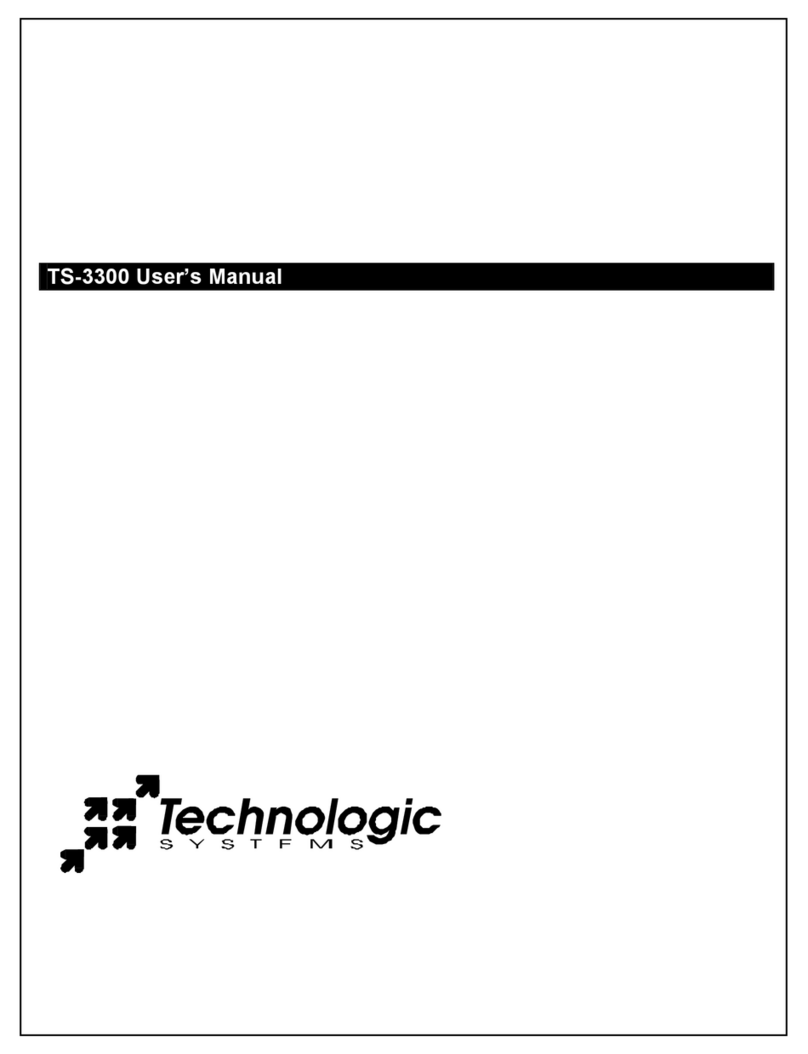
Technologic Systems
Technologic Systems TS-3300 User manual
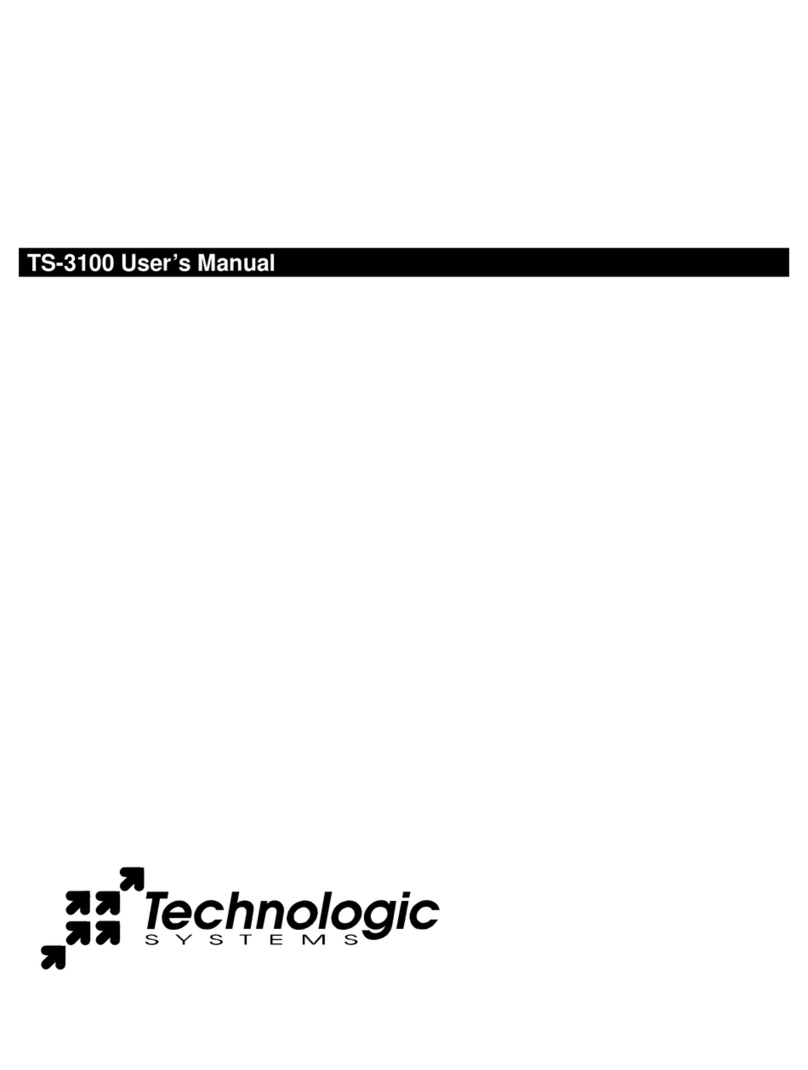
Technologic Systems
Technologic Systems TS-3100 User manual
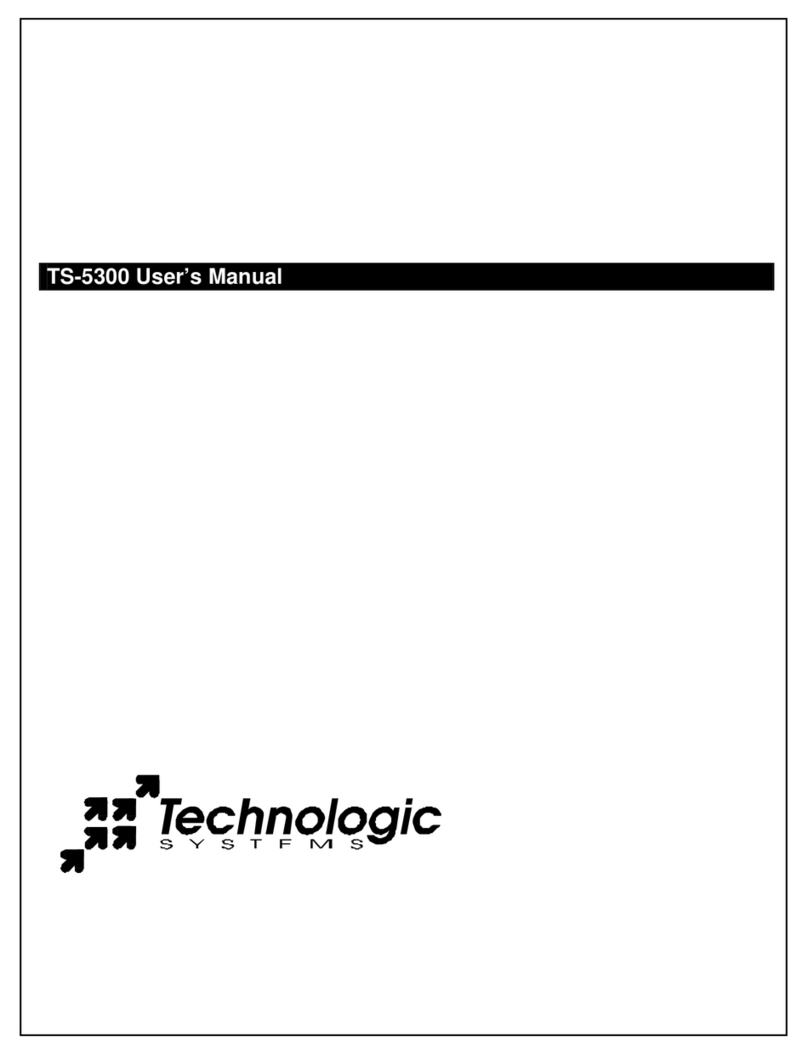
Technologic Systems
Technologic Systems TS-5300 User manual
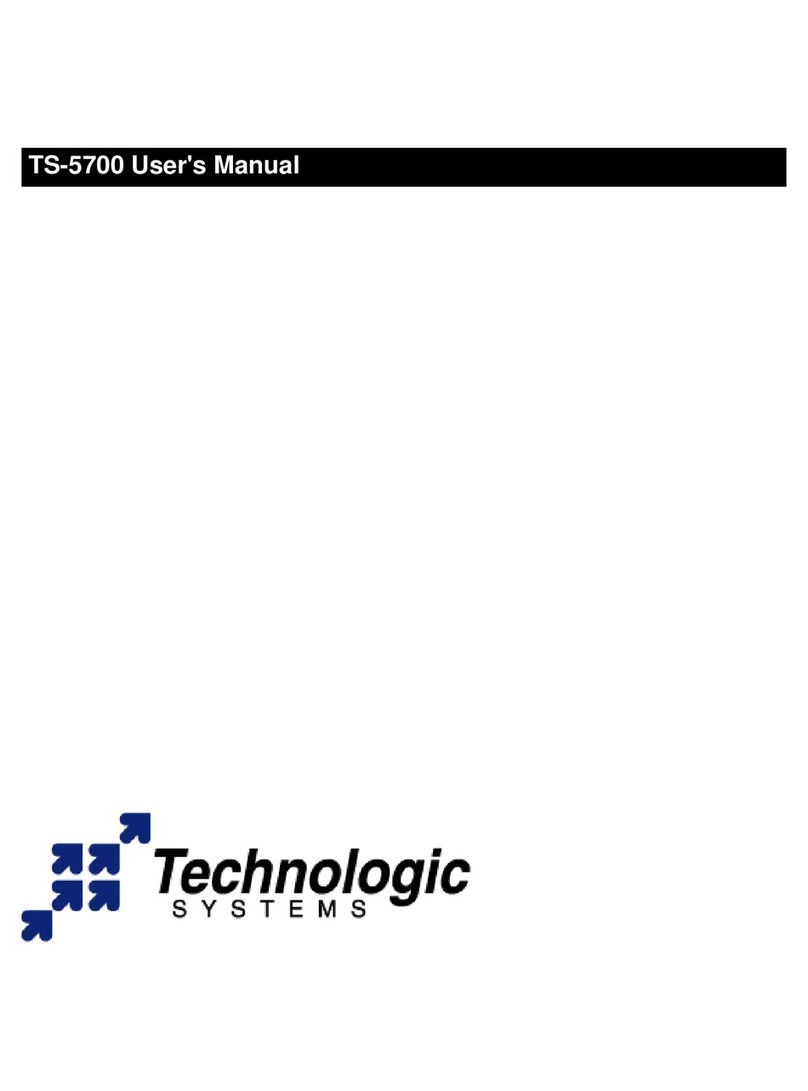
Technologic Systems
Technologic Systems TS-5700 User manual

Technologic Systems
Technologic Systems TS-2800 User manual
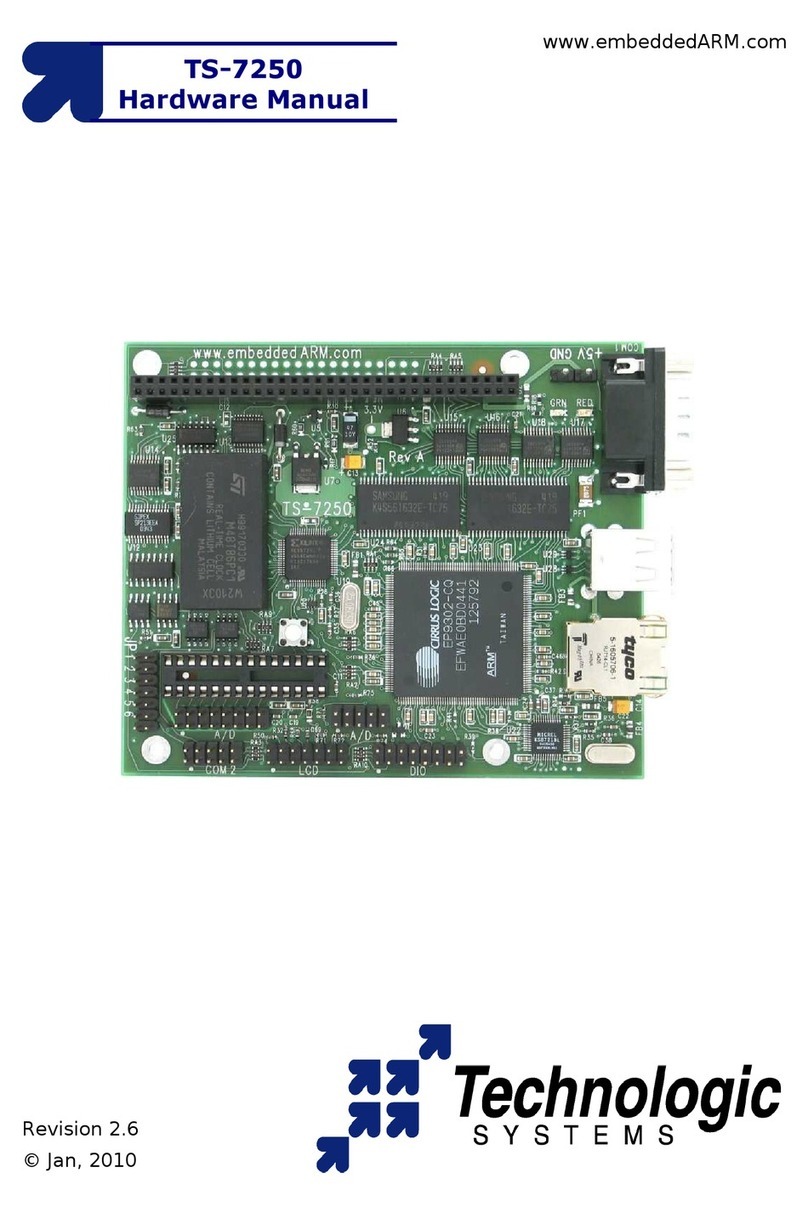
Technologic Systems
Technologic Systems TS-72XX series User manual
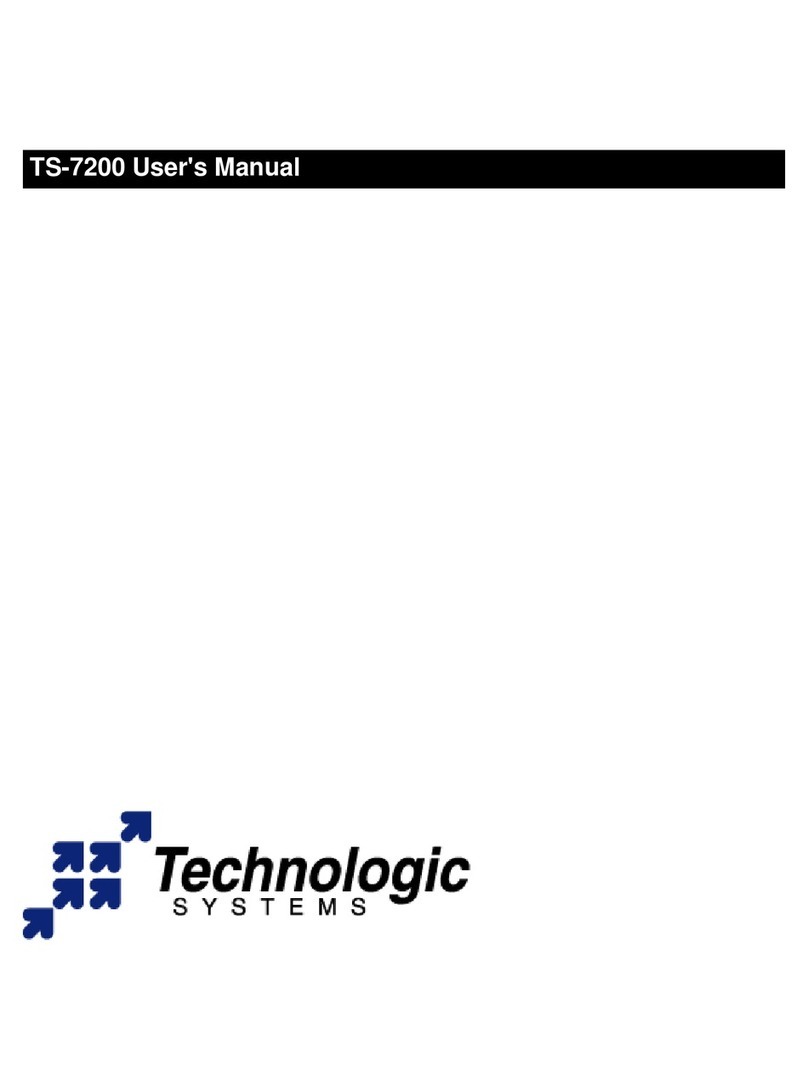
Technologic Systems
Technologic Systems TS-7200 User manual
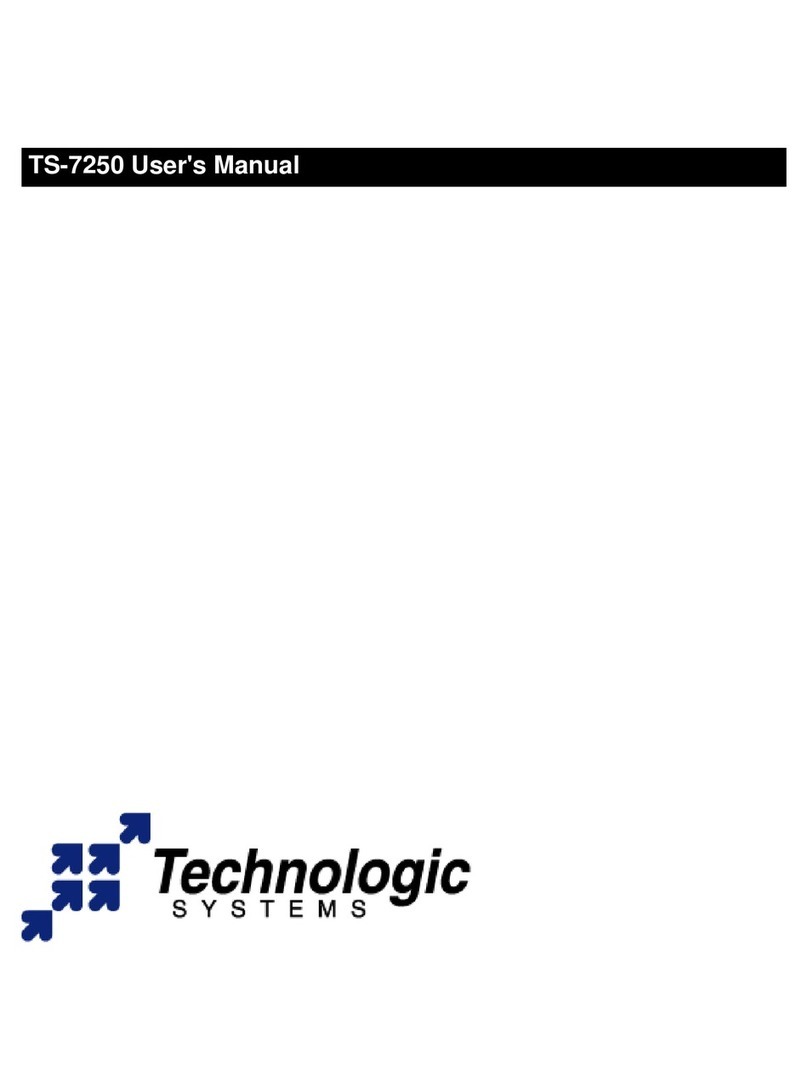
Technologic Systems
Technologic Systems TS-7250 User manual

